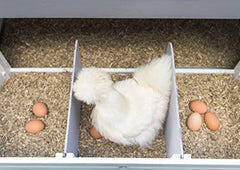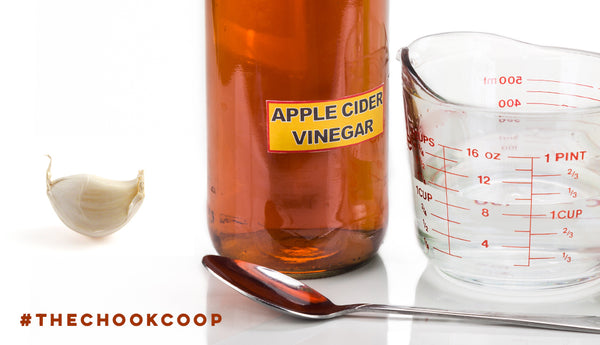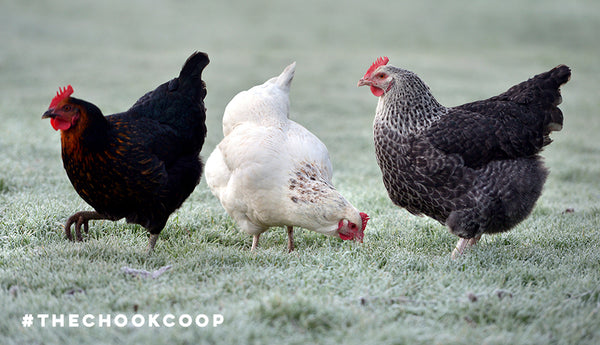We’re the first to admit that winter in Australia is pretty mellow compared to the blustery blizzards and chilly snowfalls that some chicken lovers need to defend their girls against overseas. Yes, in many parts of Australia the worst day of winter is the equivalent of the best day of summer in cities like London. That being said, there are many frightfully chilly parts of Australia, like the ACT, western parts of NSW and Tasmania, which can get quite frosty at times! No matter where you live though it’s essential that you know how to protect your chickens from cold weather, in the event that the temperature suddenly decides to drop.
What is the average winter temperature in Australia?
Winter is Australia is genuinely quite lovely, especially if you enjoy getting dressed up in your winter finest. As most Aussies know, things don’t really get that cold through June, July and August. Here are the average winter temperatures for different parts of Australia…
|
Average Winter Temps. |
June |
July |
August |
||||||
|
Minimum |
Maximum |
Minimum |
Maximum |
Minimum |
Maximum |
||||
|
Brisbane |
11.6°C |
21.9°C |
10°C |
21.8°C |
10.5°C |
23.1°C |
|||
|
Sydney |
8.9°C |
18.3°C |
7.8°C |
17.6°C |
8.7°C |
19.5°C |
|||
|
Melbourne |
6.9°C |
14.1°C |
6°C |
13.5°C |
6.7°C |
15°C |
|||
|
Canberra |
1.4°C |
12.3°C |
0°C |
11.5°C |
1.3°C |
13.5°C |
|||
|
Perth |
9°C |
18.9°C |
8°C |
17.9°C |
8°C |
18.5°C |
|||
|
Hobart |
4.3°C |
11.4°C |
3.1°C |
10.5°C |
4.5°C |
12.2°C |
|||
|
Adelaide |
8.1°C |
16.1°C |
7.5°C |
15.3°C |
8.2°C |
16.6°C |
|||
So, when it comes to uncomfortably cool conditions you definitely need to be on the lookout if you live in major cities like Hobart, Canberra and Melbourne. This being said, more rural areas around Australia have a reputation for getting very cold as well – at the end of the day, you know your area best, and if not, ask around and see what the general winter consensus is with the locals.
Your ladies are tougher than they look!
Chooks are a lot tougher than they look. They may be cute, fluffy and cuddly, but these ladies know how to withstand tough conditions with grace and poise. The important thing for chicken lovers to remember is to not just look at winter through their human perspective. Chickens relate to weather conditions very differently to you and me. In other words, you might be worried if you see your chooks free-ranging one very cold and early morning, however in reality they're probably quite comfortable. It may go against your best instincts, but if you can resist, try to avoid moving your flock back into the hutch or indoors unnecessarily.
Moisture and humidity is your enemy in winter...
That’s right, water is the key to cooling your chicken down in summer, but excess moisture and humidity in your coop on chilly winter evenings can really freeze the toes right off your poor ladies feet. Keeping a dry coop is vital if you want to keep your girls warm in winter. Here are some key things to look out for that can add excessive moisture to your coop in winter…
Spilt waterers: It may seem obvious but keeping your waterer in the coop will often result in your girls accidentally knocking it over. Spilt waterers will of course cause a lot of problems inside the hutch and can sometimes turn to ice in very cold conditions. In short, though it may seem counter intuitive, in winter it is safer to keep the waterers outside.
Rain and snow: Of course rain and snow will result in a build-up of moisture in your coop, especially if the roof leaks. At the same time it is important that your coop is still well ventilated otherwise you’ll run into a bunch of problems in both winter and summer. Our range of coops have a cute and ingenious ventilation chimney, which essentially allows the hutch to breathe, while also keeping rain and snow out, making it the perfect coop feature in both summer and winter.
Air tight coops: It’s only natural for any loving Chicken Lady to seal up her coop in winter in an attempt to keep her beloved chooks warm, but it actually has the opposite effect. An air tight coop will often result in a build-up of humidity, which will of course bring the temperature of your coop way down. Ventilation is key all year round for your chicken coop, even on those particularly chilly evenings.
Too much poop: Yes, ‘too much poop’ is never a good thing, but excessive amounts of manure in your coop through winter can be especially dangerous. Chicken manure is predominantly comprised of water, which of course, once again, results in excessive amounts of moisture and humidity in the coop if you do not clean it out regularly. Switching to highly absorbent hemp bedding is an easy way to bring the chicken manure moisture levels down in your coop, without having to clean the bedding out every few days. In addition, having pull away cleaning trays, available with the Taj Mahal, Penthouse and Mansion chicken coops, is the most convenient way to remove the soiled bedding, without getting your hands dirty.
At the end of the day you can’t really control how cold the weather gets, but you can control the amount of moisture in your coop. Preventing moisture build-up is essential if you want your ladies to stay as comfortable as possible all winter long, so, always keep an eye out for condensation, which is the best indicator of excess moisture in the coop.
How you can help your chickens stay warm naturally!
Keeping your girls warm through the winter naturally isn’t as hard as it might seem. In fact, chickens have a number of innate abilities and behaviours that help them fight the cold. Here are some things you can do and look out for this winter if you want to make sure your chooks don’t freeze their combs off!
A warm deep litter system: A deep litter system is an easy, natural and clever way to keep you chooks warm this winter. In an egg shell, a deep litter system will naturally break down old bedding, eradicate foul chicken manure odours, as well as providing a warm bed for your girls. There is of course a number of things you need to know about keeping a deep litter system, which you can read more about here.
The one leg chicken warmer trick: Throughout very cold winter you might notice that your chickens will naturally start to stand on one leg on occasion. They do this to keep one leg warm, tucked up in their plumage. No need to worry that your chooks leg is sore or damaged, it’s just this quirky thing they do to keep themselves warm.
Birds of feather fluff together: Keeping a coop full of chickens is a clever way to keep your girls warm during cold winter nights. Through the evenings chooks roost close to one another and fluff up their feathers, creating a nice little huddle of body heat. The more chooks you care for, the more body heat will be created in the coop, which at the end of the day is the friendliest way to stay warm all year round.
Eat more to stay warm: Chickens will naturally feel inclined to eat more over winter, like the rest of us. But, unlike you and me, chickens rely on extra feed to keep their core body temperature high. That’s right, chickens actually eat to stay warm over winter! That doesn’t mean you should fatten your girls up on bread, pasta and rice – though that would be nice – simply give your girls extra grain or other healthy treats to keep them warm inside and out.
Fruit and vegetable piñatas: Yes, believe it or not a cabbage or a piece of fruit tied together with string is a fabulous way to keep your ladies warm in winter. A fruit or vegetable piñata essentially keeps your girls moving and active, which in turns helps them stay warm. Also, the extra feed will power their internal furnace that will help keep the entire flock warm at night when they all roost together on the perches. Genius!
These great natural solutions are the least intrusive ways you can help your girls fight off winter’s bitter chill. However, there are a number of more artificial ways you can help your ladies stay warm…
Keeping your ladies warm in the 21st Century!
There is a lot of debate surrounding the more artificial ways you can warm your coop throughout the colder months. Here are some popular options, but I'll let you decide if it's right choice for your family's flock...
Heaters: Electronic heaters are of course a practical way to increase the temperature inside your coop, but it can pose a number of problems. Firstly, heaters can be a fire risk, and though your girls do want to stay warm, a burning coop is definitely more heat than they can handle! Also, heaters produce artificial light, which will promote extra laying throughout the winter, which is a good thing... right? Well, maybe. Artificial light will encourage your chickens to lay all season long, however some chicken lovers are reluctant to use them, as it really isn’t in their nature to lay all year long. Though there are a few negatives, at the end of a day, a heater will definitely keep your coop toasty and warm.
Wind breaks: Some dedicated chicken aficionados construct makeshift windbreaks to line their chicken’s runs, so that their chooks can graze in comfort. In many ways this is like converting your chicken run into a cold frame, but instead of using it for your garden, you use it for your chickens. Ventilation is of course a vital factor to consider – the air might be cold but your ladies still need to breathe. If you have some DIY experience and a little imagination it’s definitely worth a shot.
Insulation: Insulating your coop is definitely an engineering challenge. Naturally your inclination would be to seal the coop and line the ceiling with a popular variety of insulation, however it’s important to remember that the coop needs to be well ventilated all year round. Additionally, if the insulation is too exposed, your chickens will try to eat it, as they go a little food crazy in the colder months. In short, there are a lot of challenges you’ll face insulating a coop, but that doesn’t mean it can’t be done.
At the end of the day, if you are a savvy DIY enthusiast you should definitely try to customise your coop to withstand the winter temperatures better, however it’s best to do this from an informed and considered position. There are many factors you might not even consider that can negatively impact your flock, who a lot of the time can take winters sting in their stride.
A lot of the time having a structurally sound and well ventilated coop, like the Taj Mahal, Penthouse or Mansion, will resolve most of the issues. This being said it’s best to try and keep your girls warm naturally, like with a deep litter system, before implementing more artificial devices like heaters. Understanding what to expect from winter conditions, as well as how your chickens react to cold weather, is the key to keeping everyone safe through the season.




















